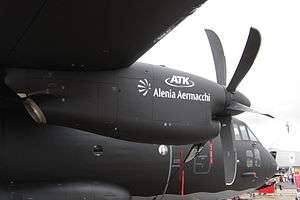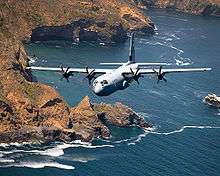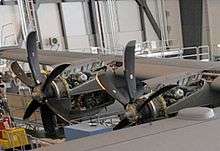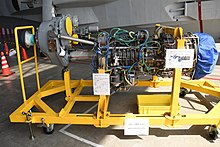Rolls-Royce AE 2100
The Rolls-Royce AE 2100 is a turboprop developed by Allison Engine Company, now part of Rolls-Royce North America. The aircraft was originally known as the GMA 2100, when Allison was a division of former corporate parent General Motors.
| AE 2100 | |
|---|---|
 | |
| The Rolls-Royce AE 2100 D2A on a C-27J | |
| Type | Turboprop |
| National origin | United States |
| Manufacturer | Allison Engine Company Rolls-Royce plc |
| Major applications | Alenia C-27J Spartan Lockheed Martin C-130J Hercules Saab 2000 ShinMaywa US-2 |
| Number built | 2,300+[1] |
| Developed from | Rolls-Royce T406 |
Development
On July 11, 1989, Saab-Scania A.B. selected the GMA 2100 to power its new Saab 2000, a 50-seat stretch of the Saab 340 turboprop, in a USD$500 million dollar deal.[2] In July 1990, Industrie Pesawat Terbang Nusantara (IPTN) of Indonesia picked the GMA 2100 as the engine for the twin-engine N-250 regional airliner.[3] Flight testing with a 13 ft 6 in diameter (4.11 m) Dowty R373 propeller on a Lockheed P-3 Orion testbed aircraft began on August 23, 1990 and finished after over 50 hours of flight and ground testing.[4]
Design
A derivative of the Allison AE 1107C-Liberty (Rolls-Royce T406) turboshaft engine, the AE 2100 shares the same high-pressure core as that engine, as does the Rolls-Royce AE 3007 turbofan. This core is capable of powering turboprops of up to 10,000 shaft horsepower (7,500 kilowatts).[5] The AE 2100 is a two-shaft design,[6]:83–84 and it was the first to use dual FADECs (full authority digital engine control) to control both engine and propeller,[7] allowing both to be adjusted with a single lever.[6]:83–84 There are four production variants of the engine: the civil AE 2100A, and the military variants which include the AE 2100D2/D2A, AE 2100D3, AE 2100J and AE 2100P.
The AE 2100 inherited the Allison T56's 14-stage axial compressor design, but the inlet and the stator for the first five stages have variable blades. The annular combustor has 16 air-blast fuel injection nozzles. The turbine that drives the compressor has two stages, with the first stage using single-crystal blades. A free power turbine with two stages drives the propeller through an inner shaft and a gearbox.[6]:83–84 The engine has replaceable steel blades and vanes, which are more reliable but heavier than titanium.[5]
The AE 2100 engine and gearbox are rated at 6,000 shaft horsepower (4,500 kilowatts), but was derated to 4,200, 4,590, and 3,600 shp (3,130, 3,420, and 2,680 kW) for the Saab 2000, Lockheed Martin C-130J Super Hercules, and IPTN N-250, respectively.[8] The engine uses six-bladed, all-composite blade Dowty propellers, including the model R381 on the Saab 2000, R414 on the ShinMaywa US-2,[7] R384 on the IPTN N-250,[9] and R391 on the C-130J military transport[10] and the LM-100J civil-certified version of the C-130J.[11] The gearbox has a reduction ratio of about 14 and a mean time before unscheduled removal (MTBUR) of over 35,000 hours.[12]
Variants


- AE 2100A
- AE 2100C
- IPTN N-250 (prototype only)
- AE 2100D2A
- AE 2100D3
- Lockheed Martin C-130J Super Hercules
- Lockheed Martin LM-100J
- Lockheed P-3 Orion (test-bed)[13]
- AE 2100F
- A variant proposed in 1995 and paired with Dowty R394 propellers to retrofit the Allison T56-powered Lockheed C-130 models E through H and Lockheed L-100-30, at a price after engine/propeller trade-in of USD$11 million per aircraft[14]
- AE 2100G
- A variant offered in 1994 for the proposed ATR 82, a twin-turboprop airliner seating up to 86 passengers and requiring about 5,000 hp (3,700 kW) of power[15]
- AE 2100J
- AE 2100P
- Saab 2000 AEW&C
Specifications (AE 2100D3)

Data from FAA type certificate data sheet no. TE1CH.[18]
General characteristics
- Type: Free-turbine turboprop engine
- Length: 124.12 in (315.3 cm)
- Diameter: 28.71 in (72.9 cm)
- Dry weight: 1,740 lb (790 kg)
Components
- Compressor: 14-stage axial
- Combustors: Annular
- Turbine: 2-stage HP, 2-stage PT
Performance
- Maximum power output: 4,637 shp (3,458 kW)
- Overall pressure ratio: 16.6:1
- Air mass flow: 36 lb/s (16.3 kg/s)[6]:83–84
- Specific fuel consumption: Takeoff: 0.41 lb/shp/h (0.19 kg/shp/h; 0.25 kg/kW/h)[19]
- Power-to-weight ratio: 2.76 shp/lb (4.54 kW/kg)[19]
See also
Related development
Related lists
References
- "Rolls-Royce reaches services contract with USAF for C-130J Fleet" (Press release). 20 September 2017 – via ASDNews.
- "G.M. engines for Saab plane". New York Times. Reuters. 12 July 1989. p. D4. ISSN 0362-4331.
- "Allison wins regional powerplant battle". Flight International. Vol. 138 no. 4225. 18 July 1990. pp. 18+. ISSN 0015-3710 – via Gale Research.
- "P3 flight test" (PDF). The Dowty Aerospace Gloucester Newsletter. No. 18. February 1991. p. 7.
- Premo, David J. (November 1991). "Allison flies solo into the new commuter aircraft market". Commuter Air International. Vol. 13 no. 11. pp. 19+. ISSN 0199-2686 – via Gale Research.
- Coniglio, Sergio (February 2010). "Military aircraft propulsion: Jets vs. props". Military Technology (MILTECH). Vol. 34 no. 2. Mönch Publishing Group. pp. 77–84. ISSN 0722-3226. OCLC 527912380 – via EBSCOhost.
- "From Rotol Airscrews to Dowty Propellers: 80 years of aviation propulsion excellence". Dowty Propellers. 21 December 2017. Retrieved 30 July 2020.
- Sweetman, Bill (October 1994). "New power for regionals". Finance, markets & industry. Interavia. Vol. 49 no. 583. Minneapolis, Minnesota, U.S.A. pp. 16–18. ISSN 1423-3215. OCLC 199793280 – via EBSCOhost.
- "IPTN rolls out with 188 orders; Gulfstream Air signs LOI for 4". Commuter Regional Airline News. Vol. 12 no. 45. 14 November 1994. p. 3. ISSN 1040-5402 – via Gale Research.
- Doyle, Andrew; Norris, Guy (28 August 1996). "Developing power". Flight International. Vol. 150 no. 4538. pp. 113+. ISSN 0015-3710.
- Broge, Jean L. (21 April 2016). "Lockheed Martin LM-100J starts taking (a similar) shape". Aerospace & Defense Technology. ISSN 2472-2081.
- Woolley, David (November 1991). "Powering up the next generation of turboprop aircraft". Commuter Air International. Vol. 13 no. 11. pp. 12+. ISSN 0199-2686 – via Gale Research.
- AE 2100 Description Archived 15 July 2011 at the Wayback Machine
- Staats, Alan (12 December 1995). "Falcon to begin C-130 re-engine programme". Flight International. Phoenix, Arizona, U.S.A.
- Burgner, Norbert (June 1994). France-Italian ATR consortium plans two new aircraft models. West Europe: Corporate Strategies. Science & Technology: Europe/International (Report). JPRS Report. JPRS-EST-94-017. Translated by Foreign Broadcast Information Service (FBIS) (published 28 July 1994). Flug Revue. pp. 30–31. hdl:2027/nyp.33433016823886.
- Casamayou, Jean-Pierre (30 May – 5 June 1994). France: Proposed engine for FLA would use SNECMA M88 core. West Europe: Aerospace. Science & Technology: Europe/International (Report). JPRS Report. JPRS-EST-94-014-L. Translated by Foreign Broadcast Information Service (FBIS) (published 8 July 1994). Air & Cosmos/Aviation International. pp. 6–7. hdl:2027/nyp.33433016823886.
- "FLA finds a new home". Finance, markets & industry: Business watch. Interavia. Vol. 49 no. 583. October 1994. p. 14. ISSN 1423-3215 – via EBSCOhost.
- Rolls-Royce Corporation (29 December 2017). Type certificate data sheet no. TE1CH (PDF) (Report) (32nd ed.). Department of Transportation (DOT) Federal Aviation Administration (FAA).
- Kaiser, Sascha; Donnerhack, Stefan; Lundbladh, Anders; Seitz, Arne (27–29 July 2015). A composite cycle engine concept with hecto-pressure ratio. AIAA/SAE/ASEE Joint Propulsion Conference (51st ed.). doi:10.2514/6.2015-4028.
- Leyes II, Richard A.; William A. Fleming (1999). The History of North American Small Gas Turbine Aircraft Engines. Washington, DC: Smithsonian Institution. ISBN 1-56347-332-1.
External links
| Wikimedia Commons has media related to Rolls-Royce AE 2100. |